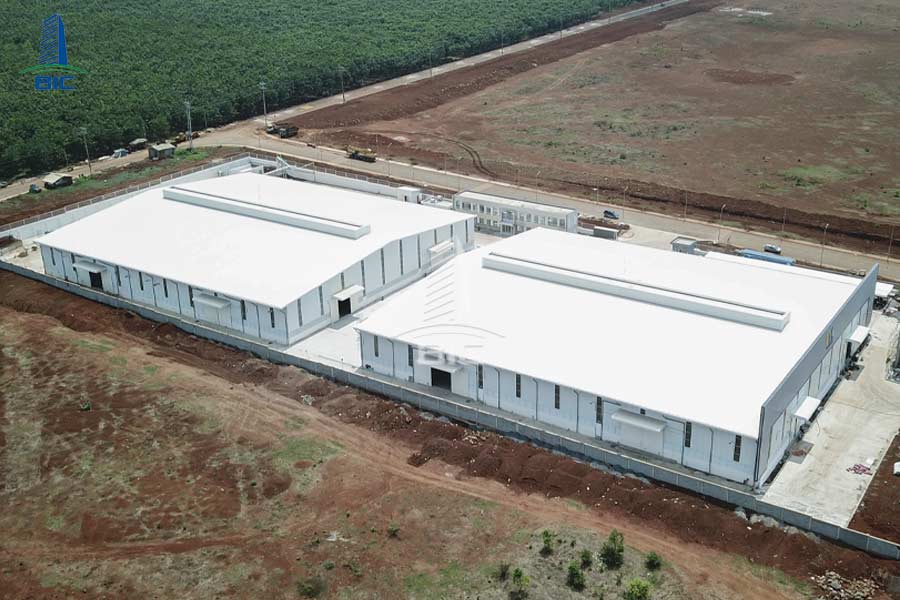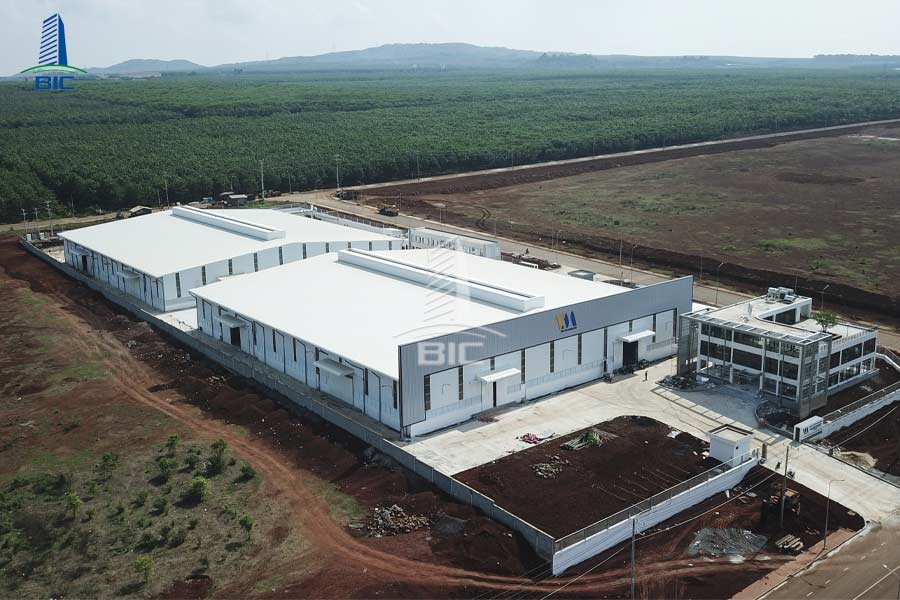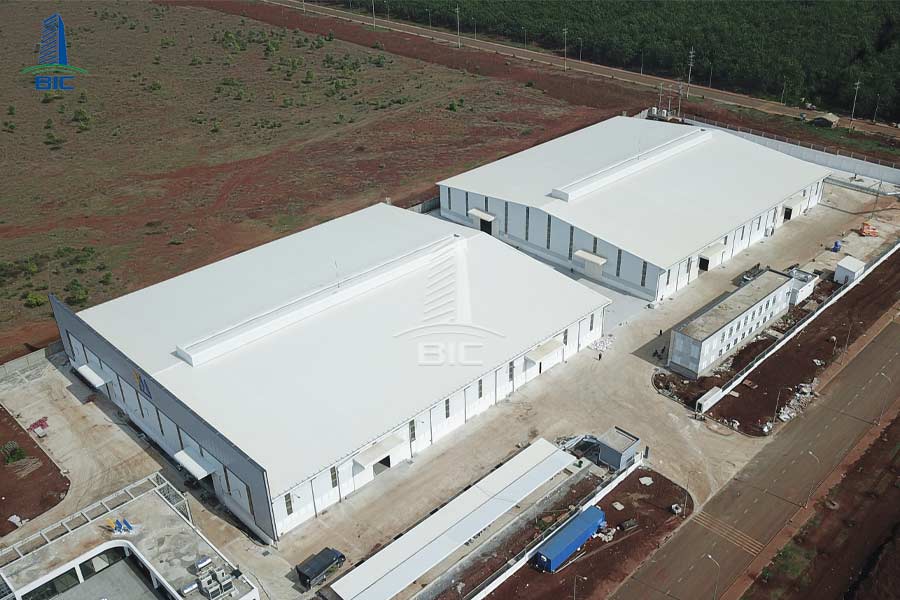
In recent years, pre-engineered buildings (PEBs) have become an increasingly popular choice for businesses investing in production and warehouse infrastructure. Prefabricated at the factory and quickly assembled on-site, this construction model significantly reduces both time and cost compared to conventional building methods. Beyond speed, PEB solutions also offer exceptional flexibility in design, making it easy to expand or modify facilities to keep up with the constantly changing demands of modern industry.
One of the biggest advantages of PEBs is their ability to combine the durability of steel structures with cost-effectiveness in operation. When constructed in compliance with proper standards, these buildings not only ensure load-bearing capacity and resistance to wind and storms but also optimize functional space, lower maintenance costs, and extend the building’s lifespan. This is a key factor in helping businesses maximize investment capital and enhance long-term production efficiency.
With extensive experience in industrial projects, BIC affirms that choosing pre-engineered steel buildings delivers outstanding benefits from rapid project completion and cost savings to building a sustainable infrastructure foundation. As a result, more and more investors are prioritizing this solution as a strategic direction to boost competitiveness in today’s dynamic industrial landscape.
A pre-engineered building (PEB) is an industrial facility whose main components are prefabricated in a factory and then transported to the site for final assembly. Unlike traditional construction, which involves lengthy on-site processes, PEBs streamline the workflow by minimizing on-site work while still ensuring structural integrity and quality.
A typical PEB consists of three main components:
- Main frame: Built from fabricated steel members, calculated to bear the designed loads.
- Secondary structure: Includes purlins, bracings, and sub-beams that support the main frame and enhance overall stability.
- Enclosure and finishing: Consists of roofing sheets, insulated wall panels or metal cladding, combined with doors, ventilation, and lighting systems.
Thanks to industrialized production, each component is fabricated with high precision and then bolted together on-site, ensuring structural uniformity and minimizing errors compared to manual construction methods.
Pre-engineered buildings are increasingly popular across various sectors from mechanical manufacturing, food and pharmaceuticals, to logistics and warehousing. Businesses value this construction model for its rapid build time, cost efficiency, and design flexibility. Moreover, modern PEB solutions can easily integrate green technologies, such as solar panels and natural ventilation systems, helping reduce energy consumption and promote environmental sustainability.

PEBs are becoming the preferred construction solution for many companies thanks to numerous advantages over traditional building methods.
Since components are fabricated in advance, steel structures can be quickly assembled on-site using bolts, minimizing cutting and welding work. This dramatically shortens the construction schedule typically 30–50% faster than traditional reinforced concrete buildings. Faster completion means businesses can put facilities into operation sooner, saving on land rental costs and accelerating return on investment.
PEBs often cost less to build thanks to optimized material use, reduced on-site labor, and minimal material waste. Additionally, the lightweight yet strong steel structure lowers foundation loads, cutting foundation treatment costs compared to reinforced concrete buildings. In the long term, maintenance and repair costs are also lower due to high durability and easy replacement of individual components.
A major advantage of PEBs is their high design flexibility. Businesses can easily expand or remodel the facility without significantly affecting the main structure. Open-plan designs and large clear spans provide spacious interiors suitable for various industries, including manufacturing, logistics, and warehousing. This flexibility is especially valuable for companies planning future expansion.
Steel frames in PEBs are designed to international standards, capable of withstanding heavy loads and harsh weather conditions such as strong winds and heavy rain. With regular maintenance, these structures can last 30 to 50 years, ensuring long-term operational stability and enhancing asset value.
PEBs use a high proportion of recyclable materials, reducing construction waste compared to traditional methods. They can also integrate green solutions like solar roofing, natural ventilation, and energy-efficient lighting systems. These features lower operating costs while demonstrating social responsibility and improving corporate reputation in the eyes of global partners.

When selecting a facility type, many businesses weigh the choice between pre-engineered buildings and conventional reinforced concrete construction. Each has its pros and cons, but PEBs are gaining the upper hand thanks to their flexibility and cost-effectiveness.
PEBs can be completed in nearly half the time of traditional buildings. Components are prefabricated and assembled on-site in just a few weeks. In contrast, reinforced concrete structures require formwork, concrete pouring, and curing time, often stretching the construction period over several months.
PEBs typically save 15–30% in construction costs due to reduced material use, labor, and shorter timelines. Maintenance costs are also lower, as steel structures are easy to inspect and replace. On the other hand, reinforced concrete buildings have higher initial costs and more complex repair and renovation processes.
Steel frames allow for large clear-span spaces without interior columns, creating open areas ideal for production layouts. Expanding the building later is simple just add frames or dismantle sections without disrupting the entire structure. Traditional buildings are less flexible, and expansions are often expensive and time-consuming.
PEBs can incorporate modern architectural features such as insulated panels, skylights, large windows, and solar systems, resulting in a more professional appearance. Traditional buildings, primarily focused on concrete structures, are less adaptable to aesthetic improvements and green technology integration.

Thanks to their flexibility, durability, and cost-effectiveness, PEBs are widely used across many industrial sectors. Depending on production requirements and scale, businesses can fully leverage the advantages of this construction model.
Mechanical plants often require large, column-free spaces with high load capacity and flexible equipment layouts. PEBs meet these needs with wide-span steel frames and easy expansion options.
PEBs are commonly used for warehouses, distribution centers, and cold storage facilities. Fast construction and cost efficiency allow businesses to put facilities into operation quickly, meeting the growing demand for storage and distribution.
These sectors demand highly sanitary environments and modern fire protection and HVAC systems. PEBs can integrate such solutions from the design stage, ensuring efficient and safe production operations.
Beyond industrial use, PEBs are also applied in commercial projects such as supermarkets, exhibition centers, and service complexes. Their flexible design allows for the integration of production, display, and office functions within a single facility.
Beyond initial construction speed and cost advantages, PEBs offer numerous long-term benefits, helping businesses optimize operational efficiency and maintain market competitiveness.
Thanks to their durable steel structures and efficient designs, PEBs require minimal periodic maintenance. Materials like galvanized steel, insulated roofing, and wall panels are long-lasting and easy to replace individually, saving substantial operational costs over time.
As production demand grows, PEBs can be quickly expanded by adding frames, extending, or elevating the structure without disrupting current operations. This is a major advantage over traditional concrete buildings, which require more complex and costly renovations.
A well-designed PEB not only supports smooth production operations but also enhances land use efficiency. Spacious, column-free interiors allow for optimal equipment placement and storage. Additionally, PEBs have higher resale value due to their ability to be dismantled, reused, or repurposed across various industries.
The rapid growth of modern industry has proven that pre-engineered buildings are an optimal solution not only helping businesses save on construction costs and time but also delivering sustainable value during operation. With their design flexibility, easy scalability, and ability to integrate green technologies, PEBs are playing an increasingly vital role in industrial and logistics infrastructure.
Choosing a properly designed pre-engineered building from the outset ensures safety, efficiency, and long-term competitive advantages. However, to maximize the value of such projects, investors should work with experienced, reputable consultants and contractors capable of delivering large-scale industrial projects.
With extensive expertise in factory construction, BIC is committed to delivering comprehensive pre-engineered building design and construction solutions that combine modern technical standards with cost optimization. By partnering with BIC, businesses gain not only high-quality, safe facilities but also a robust infrastructure foundation for future expansion and sustainable growth.